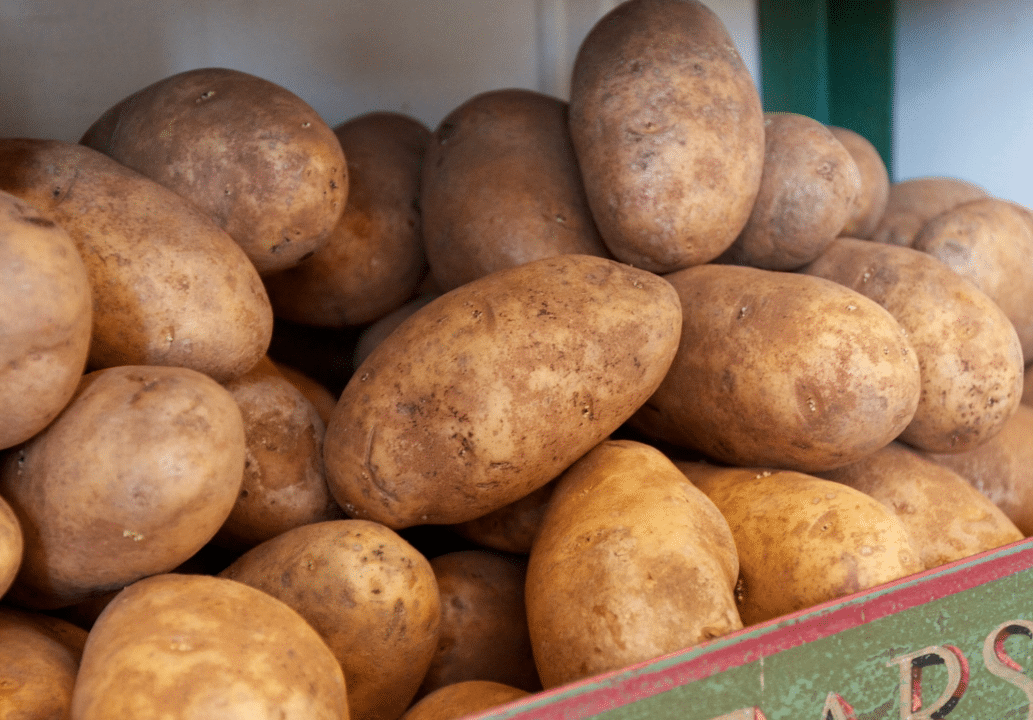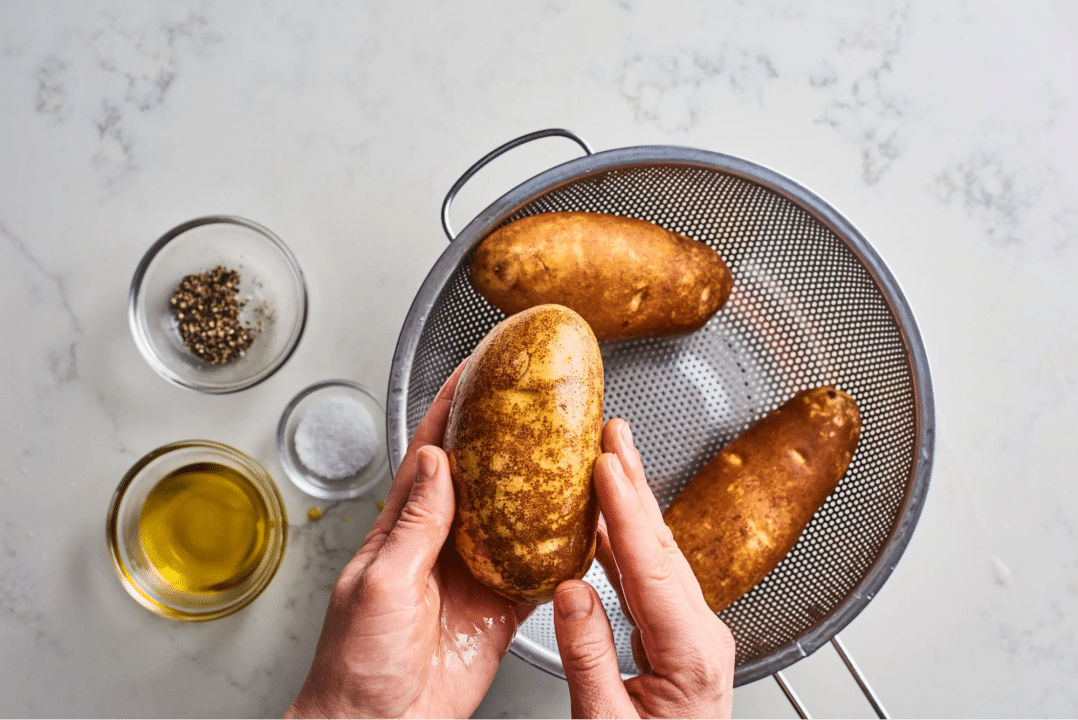No products in the cart.
0 - £0.00
- 0 items
- view cart
No products in the cart.
If you’re looking for a jacket potato with a light, airy texture, go no further than fluffy potatoes. Maris Piper or Kind Edwards are wonderful options if you’re looking for a particular kind of “baking potatoes.”
Potatoes that have been roasted in the oven until they are soft and fluffy are often called “pumpkin” in the United States. There is no distinction between the two. Jacket refers to the outer layer of the potato, independent of how it is cooked: in water, oil, a dry oven, or even roasting.
Those baked potatoes with fluffy interiors, ready for a sprinkle of fresh chives or a slew of your favorite toppings, are a comfort food classic. They taste like pure, nostalgic, cozy carbohydrate bliss, and they serve as a reminder of how gratifying a basic potato can be.
Even though it’s tempting to devour the entire thing hot out of the oven, you won’t be able to resist adding a pat of butter or a dollop of (cashew) sour cream to make it taste even better.
Let’s not only water our mouths, but get started with cooking some jacket potato.
In cafes, canteens, and home kitchens, the jacket potato is a go-to favorite meal since it’s tasty, filling, and comes with a plethora of topping possibilities.
Jacket potatoes are a budget-friendly, filling option that should be a regular in your recipe rotation. Tips for cooking a jacket potato to perfection are here. For good measure, we’ve thrown in a couple of our own delectable recipes.
You may, for example, choose from the following categories:
In theory, every kind of potato may be used to produce baked potatoes. But…
If you want to get the most out of your potatoes, you’ll need to pick fluffy ones. Fluffy potatoes, which tend to be bigger in size, are ideal for creating a jacket potato with a light, airy texture. When looking for a particular kind of “baking potato,” Maris Piper or Kind Edwards are suitable options.
When it comes to baking potatoes, we’ve found that Russets are the finest kind to use. Russet potatoes have thick skins that enable them to crisp up properly in the oven.
Pectin is found in the cell walls of potatoes, and even when exposed to acids, the pectin chains stay stable. You’ll get a hard spot and maybe uneven cooking if you bake potato with one side contacting a sheet pan. Place a rimmed baking sheet on top of a wire rack.
A potato should be cooked until it appears wrinkled on the exterior and gives when squeezed – around 40 to 50 minutes, depending on its size. To see whether the potato is soft, stick a fork into it and see if it comes out cleanly.
Now let’s get it on with our main event and get started cooking those potatoes;
Baked russets are fluffy due to their high starch content and low moisture content. Crispy skin is also a plus. To ensure that they are all cooked at the same time, use medium-sized potatoes (each around half a pound in weight).
In theory, every kind of potato may be used to produce baked potatoes. But if you want the best-baked potatoes, we recommend using Russets. Russet potatoes have thick skins that enable them to crisp up properly in the oven. In addition, the starchy inside creates a sweet and fluffy filling.
You can take any thick potato you want. There is not much of any restriction about that.

The skin should be washed and scrubbed with cold water. Because they are dug out from the ground, a lot of dirt is left behind. Before you bake your raw potato wedges, give them 10 minutes of hot water soak time. This procedure allows the potatoes to absorb moisture and release part of their starch, resulting in potatoes with crispy skins and wet interiors.
Using a fork, we suggest piercing the potato 8 times with 1/8-inch-deep pricks around. Cool water should be used to scrub and rinse the potatoes’ exteriors. Fork-prick each potato eight times, approximately 1/8-inch deep.
The perforations in the lid let steam to escape while cooking, which reduces the risk of spills and explosions. Season the potatoes with kosher salt by lightly brushing or rubbing them with olive oil or vegetable oil. Sprinkle salt on top of the olive oil and let it sit for a few minutes. Place one potato at a time on a microwave-safe dish, or two potatoes at the most.
Before baking, you may apply a substantial amount of black pepper to the potato skin; after baking, you can sprinkle a few generous cracks of black pepper over the potatoes’ fluffy interiors.

Set the temperature of your oven to 450 degrees Fahrenheit. The oven must be quite hot in order to immediately crisp the potato skins. As a general rule of thumb, baked potatoes should take anywhere from 35 to 55 minutes to cook, or more than an hour to cook if you’re using large, hulking potatoes. The amount of time a potato needs to bake is determined by its size.
Your baking sheet should be ready. The potatoes will cook more evenly on all sides if you use a wire cooling rack placed on top of a baking sheet. Even if you don’t have a wire rack, you may use a foil-lined baking sheet or bake the potatoes directly on the oven racks with a baking sheet underneath for any drips.
Use a fork to prick the potato all over. Because exploding potatoes are a pain to deal with. Pressure develops within the potato while it cooks because of the increased production of steam. The potato will burst in your oven or microwave if the pressure is too great and the potato and its skin cannot withstand it.
When it comes to baking a potato, we recommend doing it in two batches. First, bake for approximately 25 minutes, until the skin begins to dry and wrinkle. Remove the potato from the oven with care. Brush the potato all over with melted butter or oil using a pastry brush. Using kosher salt, generously season the potato before cooking. Our recommendation is to use coarse Kosher salt in order to give the potato skins a little snap.

Add another 20 minutes to the baking time. Then, using an oven mitt to test the potato’s doneness (it will be hot), delicately squeeze it. Remove the potato from the oven if the insides are mushy and yield under pressure. Place the potatoes on the oven rack in single layers to ensure uniform dispersion of heat.
Use a hot mitt to remove the potatoes and lay each one in a piece of foil before wrapping them. This will help keep out the oven’s dry heat. If not, cook for a further 5 minutes at a time until the potato is done. Depending on the size of the potatoes, cooking time may vary but plan on 45-55 minutes on average.
It is possible to fit up to 48 – 50 potatoes in a 30-inch oven with three rows of eight potatoes each, or 24 – 25 potatoes per shelf (3 rows of 8 each). Plan on cooking 17-19 potatoes per rack or 34-38 potatoes per oven when using 16-ounce potatoes.
Squeeze, fluff, season, and serve! That’s all there is to it! Finally, use a paring knife to split open the potato lengthwise, press it open, and fluff the insides with a fork before adding your preferred spices or garnishes. Afterward, you’ll have a baked potato that’s crispy on the exterior, soft and fluffy on the inside, and really wonderful!

Yes. It’s best to eat the skin to get the most nutritional value out of your russet potatoes. More nutrients are found in the potato’s outer skin than it is in the potato’s flesh. Almost half of a medium potato’s fiber comes from the skin, making it an excellent source of fiber.
Antinutrients and potentially toxic chemicals are more likely to be present in raw potatoes, making them more prone to cause stomach problems. However, they have a greater concentration of vitamin C and resistant starch, which may have strong health advantages. In reality, both raw and cooked potatoes may be part of a healthy diet if consumed in moderation.
Baked potatoes should not be wrapped in aluminum foil. The “cooked” flavor and texture of potatoes are a consequence of steaming them in foil. In order to “bake” potatoes in the microwave, wash them but don’t dry them out completely. Place them one inch apart on a microwave rack, pierced and wrapped in paper towels that can be used in the microwave.
Yes, pricking them is an excellent idea. Make pores in the skin so that steam may be expelled. Or they might blow up. It doesn’t happen very often, but it does happen sometimes. The potato has a lot of water in it, and it’s attempting to evaporate that water vapor into steam.
Although roasting potatoes in foil are considered to hasten the cooking process, this is not the case with my crispy skinned potatoes. If you like potatoes with softer skin, baking them in foil will accomplish your goal.
Following the above procedures, you can easily cook Jacket Potato. Actually, it is one of th easiest recipes. Also, you don’t have to worry about storing it.
Cooked jacket potatoes keep for up to two days in the refrigerator. Jacket potatoes may be stored in the freezer for up to three months if they are cooled and wrapped in foil before being stored in a food container. Bake at 200°C, 180°C Fan, Gas Mark 6 for 40 minutes, or reheat in the microwave for the same time period.
So what do you think of these steps? Please do let us know in the comment section (Plant Sumo).
⭐️⭐️⭐️⭐️⭐️ Plant Sumo’s Soul Curry has been the perfect fully plant based substitute for my favorite curry dishes and I look forward to this option with each order :) – Lydia Sims
Plant Sumo is a part of the Pearl Lemon Group . We also run three Cafe’s – Pearl Lemon Café (w/lots of plants), Pearl Lemon Catering, Pearl Lemon Boba, and How Matcha (come visit) in London!
© All Rights Reserved | Company Number: 10411490 | VAT Number: 252 7124 23 | Sitemap